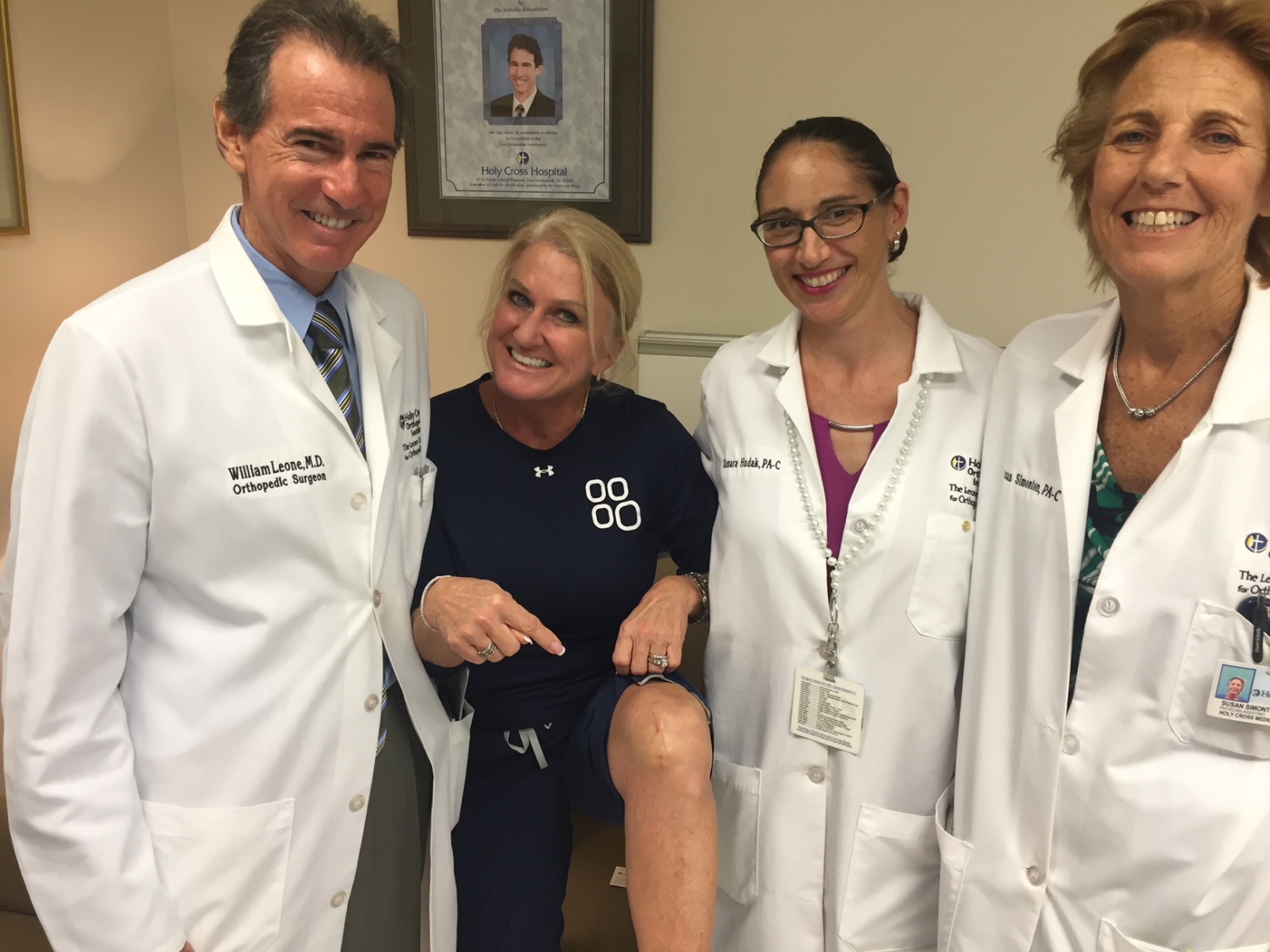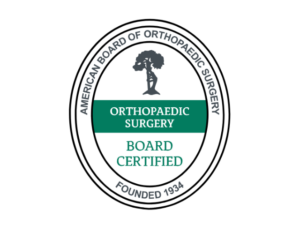Total Knee Replacement Surgery
Knee replacement surgery involves removing all or part of a diseased knee joint and replacing it with an artificial knee joint or prosthesis. Frequently, it is pain and damage from arthritis that leads patients to surgery. Knee arthritis can result from past trauma, infection, autoimmune disease such as rheumatoid arthritis, and surgical interventions such as arthroscopy. Often, there is a genetic predisposition.
If abnormal biomechanics from knock knee deformity (genu valgus) or bowlegged deformity (genu varus) led to the arthritis, then the surgery must also correct the abnormal knee alignment. We are seeing an exponential increase in the number of knee replacements performed in America each year and, not unrelated, we are seeing an exponential increase in obesity.
Knee replacement surgery is generally performed when limitations and painful symptoms can no longer be controlled with non-operative treatments.
In Total Knee Replacement surgery (TKR), the bone and cartilage on the bottom end of the thigh bone (femur) and top of the shin bone (tibia) are removed. This is performed using precise instruments to create surfaces that will accommodate the implant perfectly. Computer navigation and robotic technology have wonderfully improved our precision and made the results even more predictable. A metal implant that is shaped like our natural femur is placed on the femur. A metal tray and plastic insert are implanted on top of the tibia. The underneath surface of the patella or kneecap is also removed and replaced with a plastic button. Now as the new knee moves, only specialized plastic moves against the new metal femoral component.
Pain is reproducibly relieved and function returned if the soft tissue sleeve that supports the knee is balanced, the limb realigned and normal knee movement or kinematics restored. Our ability to achieve this consistently has been greatly enhanced by the advent of kinematic sensor technology, a game changer for TKR. We implant a trial plastic insert temporarily. The insert is made with a microcomputer chip and pressure sensors that allow me to precisely measure inter-compartmental loads (measure the loads in the inner and outer compartments of the knee) and the location of these loads. Data from the kinematic sensor provides a “road map” for how to align the components and balance the soft tissue sleeve for optimal knee kinematics and function.
Partial Knee Replacement Surgery
Frequently, one part of the knee or one compartment develops symptomatic osteoarthritis first, and then over time, the breakdown of the joint progresses to include the other two compartments of the knee. Often, osteoarthritis starts in the medial or inner compartment and can result in the leg appearing “bowlegged.” We call this condition genu varus. Less frequently, the outermost part of the knee joint or lateral compartment initiates the arthritic process. The patient’s leg may look “knock kneed.” This condition is referred to as genu valgus. Finally, the articulation between the kneecap and femur can become arthritic and painful. Often this patellofemoral joint will wear out secondary to the arthritic process which first starts in one of the other two compartments. Imagine how the tracking of the patella becomes compromised as the alignment of the leg/knee is altered. Eventually, all three compartments become involved in the arthritic process.
A partial knee replacement (PKR) attempts to interrupt this progression by only treating the involved compartment(s). Most patients report a much faster and easier recovery than after a TKR because significantly less dissection is done. Many patients also report that the partial knee replacement feels “more natural” than TKR. This may be because there is less interruption to normal neurologic pathways and because the cruciate ligaments and the uninvolved compartments are not violated.
Critical to getting a great result are appropriate indications and then perfectly implanting the components and balancing the soft tissue sleeve. Although in the past, PKR was considered less consistent than TKR, new advances in robotics, and specifically the MAKO robotic-assisted technique, have vastly improved our ability to optimize component position and track and balance the partial knee. With improved accuracy and reproducibility, PKR has become an elegant and wonderfully effective way to treat certain conditions.
Revision Knee Replacement Surgery
Revision knee replacement surgery is surgery performed on a person who has already undergone total knee replacement surgery. Typically, a revision surgery requires more operative time, expertise and special equipment and has a higher risk for complications. Revision surgery involves removing the old prosthesis and replacing it with a new one. The procedure often requires a more extensive incision and dissection.
Fortunately, the advent of specialized instruments and revision prosthesis combined with new techniques and has markedly improved the outcomes on these complex re-do surgeries. Bone ingrowth cones and combined with modular revision implant systems and special bone grafting procedures has vastly improved our ability to reconstruct the knee and achieve an excellent and predictable result. Kinematic sensor technology is also being used to help diagnosis more precisely any kinematic imbalance and assess the relationship between the femoral and tibial component more precisely so any problems can be directly addressed.
Click to read Dr. Leone’s blog: Should My Knee Still Hurt 1-2 Years after Total Knee Replacement Surgery
Knee Arthroscopy
Knee Arthroscopy is an outpatient surgical procedure that can be used to diagnose and treat problems in the knee joint. Two or three very small incisions are made to allow a tiny camera to be inserted and project images of the inside of the knee on a screen. It often allows a precise diagnosis of the patient’s condition. Using tiny specialized instruments, many condition can be repaired such as meniscus and ligament tears. Knee arthroscopy is not an effective treatment for advanced arthritis or symptoms that are caused by the arthritic condition.
There are limited risks to the procedure and the outlook is good for most patients. Your recovery time and prognosis will depend on the severity of the knee problem and the complexity of the required procedure.
See Video Testimonials From Dr. Leone’s Patients- click here
Treatments
Primary Total Knee Replacement
Partial Knee Replacement
Revision Total Knee Replacement
Knee Arthroscopy
Open or Closed Reduction with Internal Fixation of Fractures




